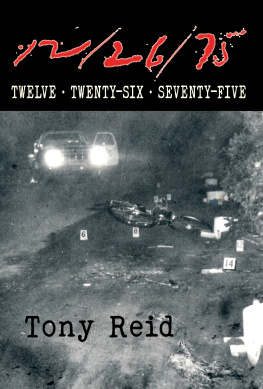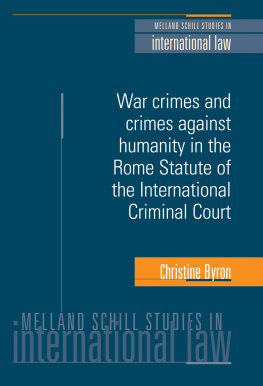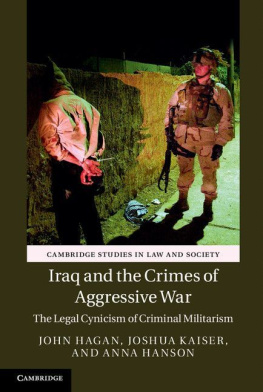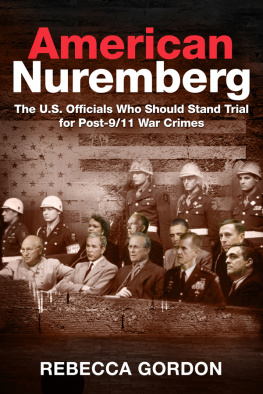THE DEVILS GARDEN
Related Titles from Potomac Books
Getting Away with Torture: Secret Government, War Crimes, and the Rule of Law, by Christopher H. Pyle
The Secrets of Abu Ghraib Revealed: American Soldiers on Trial, by Christopher Graveline and Michael Clemens
Harvest in the Snow: My Crusade to Rescue the Lost Children of Bosnia, by Ellen Blackman
THE DEVILS GARDEN
A WAR CRIMES INVESTIGATORS STORY
JOHN R. CENCICH, SPECIAL AGENT, USAF (RET.)
Foreword by Christian Chartier

2013 by the Board of Regents of the University of Nebraska
All rights reserved
Potomac Books is an imprint of the University of Nebraska Press
Library of Congress Cataloging-in-Publication Data
Cencich, John R., 1957
The devils garden : a war crimes investigators story / John R. Cencich, Special Agent, USAF (Ret.).
pages cm
Includes bibliographical references and index.
ISBN 978-1-61234-172-9 (hardcover : alk. paper)
ISBN 978-1-61234-173-6 (electronic)
1. Miloevic, Slobodan, 1941-2006Trials, litigation, etc. 2. International Tribunal for the Prosecution of Persons Responsible for Serious Violations of International Humanitarian Law Committed in the Territory of the Former Yugoslavia since 1991. 3. Criminal investigationInternational cooperation. 4. Yugoslav War Crime Trials, Hague, Netherlands, 1994- 5. Yugoslav War, 1991-1995Atrocities. I. Title.
KZ1203.M55C46 2013
341.690268dc23
2013003489
Printed in the United States of America on acid-free paper that meets the American National Standards Institute Z39-48 Standard.
Potomac Books
22841 Quicksilver Drive
Dulles, Virginia 20166
First Edition
10 9 8 7 6 5 4 3 2 1
To war crimes investigators throughout the world,
Let justice be done though the heavens fall.
From the Latin maxim
Fiat justitia ruat caelum
CONTENTS

Political map of Yugoslavia following World War II. Reprinted from The Palgrave Concise Historical Atlas of the Balkans by Dennis P. Hupchick and Harold E. Cox

Political map of the successor states of the former Yugoslavia. Reprinted from The Palgrave Concise Historical Atlas of the Balkans by Dennis P. Hupchick and Harold E. Cox

Map of Mostar and the surrounding area in Bosnia, including Sovii, Doljani, and Ratani. Source: NATO

Map of Croatia showing Serbian regions, major crime sites, Lokve, and the Gorski Kotar region. Base map courtesy of the University of Texas Libraries, The University of Texas at Austin; additions and modifications by S. C. Spangler
FOREWORD
In the summer of 1992, TV reports were broadcast across the globe that showed pictures, reminiscent of the Holocaust, of emaciated prisoners behind barbed wire in concentration-like makeshift camps. These were followed by the graphic images of the shelling of the jam-packed central market in Sarajevo, a city under siege. Other reports of mass killings, ethnic cleansing, and systematic rape and torture were widespread, including the abduction and murder of more than two hundred wounded hospital patients in Vukovar, Croatia. Outraged Western public opinions eventually pushed the international community into actionthe International Criminal Tribunal for the former Yugoslavia (ICTY) was born, the first ever really international criminal tribunal.
Help was needed to investigate and pursue war criminals, and it quickly came from the White House. Like the establishment of the landmark trials of the major Nazi and Japanese war criminals in Nuremberg and Tokyo in the wake of World War II, the U.S. government was a driving force behind the ICTY. The UN Security Council exercised its powers under Chapter VII of the Charter of the United Nations, which authorized the Council to take measures to maintain or restore international peace and security. Consequently, the ICTY was officially established in 1993. All of this was done under the sound and clear pressure of strong diplomats. This included the then U.S. ambassador to the United Nations Madeleine Albright, who solemnly avowed to the Security Council and the world, There is an echo in this chamber today. The Nuremberg principles have been reaffirmed. The lesson that we are all accountable to international law may finally have taken hold in our collective memory.
These were the diplomatic and political efforts that brought about this truly historical event. Yet politicians dont bring criminals to the dock, and help was needed to commence the investigations that would eventually result in war crimes trials. From that day on, the Clinton administration, followed by the Bush administration, spared no effort to assist this completely new court of law in many ways. One of its main contributions was to make available skilled prosecutors, expert investigators, and experienced law enforcement officers. The U.S. government immediately seconded staff to the tribunal and promoted UN recruitment efforts through the State Department.
I remember quite well when, in the autumn of 1998, American investigator John Cencich, the author of The Devils Garden, arrived in The Hague in the Netherlands to work in a new venue. It is one that he describes quite accurately in his book as the true end game for war, violent crime, and espionage, and a place where the masks were taken off the men who committed crimes that shocked the conscious of humanity. As an international civil servant and UN appointee, John was precisely one of these gems who worked day and night on missions throughout the Balkans and in many other parts of the world in order to expose the atrocities and bring those responsible to justice.
At the time perceived by many as a fig-leaf or a toothless tiger, the ICTY progressively became a feared investigative and prosecution body. There is no mistaking that John Cencich is one of these determined experts who, always working tirelessly and frequently under dangerous conditions, made this happen. You will see this through The Devils Garden, a one-of-a-kind legal thriller. And while respecting the confidentiality demanded of UN appointees, it is a stunning revelation of their everyday work, both at the ICTYs seat in The Hague and on various locations throughout Yugoslavia.
Johns ultimate goal, and that of his fellow international war crimes investigators coming from no less than fifty different countries, was to link senior political and military figures with the many crimes committed throughout the former Yugoslavia. A once solid, multi-ethnic federation, which in the 1990s was torn apart by brutal inter-ethnic conflicts, became the scene of atrocities at a level not seen in Europe since World War II. I need not list them. The Devils Garden provides a nailing account of the crimes against humanity that were committed by regular military forces, paramilitary militias, police, and even by individuals who, all of a sudden, turned against their former friends and neighbors.
Next page









